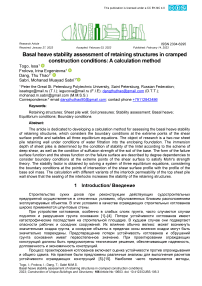Оценка устойчивости к базальному пучению подпорных конструкций в стесненных условиях строительства: метод расчета
Автор: Того И., Фролова И.Е., Данг Т.Т., Сабри М.М.С.
Журнал: Строительство уникальных зданий и сооружений @unistroy
Статья в выпуске: 1 (105), 2023 года.
Бесплатный доступ
Статья посвящена разработке расчетного метода оценки устойчивости к базальному пучению подпорных конструкций, учитывающего граничные условия в крайних точках профиля поверхности сдвига и удовлетворяющего всем трем уравнениям равновесия. Объект исследования – двухрядная шпунтовая подпорная стена в условиях фильтрации воды в ограждающий фундамент. Глубина погружения шпунтовых свай определяется условием устойчивости перемычки по схеме глубокого сдвига, а также условием суффузионной прочности грунта основания. Форма функции поверхности разрушения и функция напряжения на поверхности разрушения описываются степенными зависимостями для учета граничных условий в крайних точках поверхности сдвига для удовлетворения теории прочности Мора. Коэффициент устойчивости получается путем решения системы трех уравнений равновесия с учетом граничных условий в точках пересечения профиля поверхности сдвига с профилем основного грунтового массива. Расчет с различными вариантами проницаемости замков верхней шпунтовой стенки показывает, что герметизация замков повышает устойчивость подпорных конструкций.
Подпорные конструкции, шпунтовая стена, давление на грунт, оценка устойчивости, пучение основания, условия равновесия, граничные условия
Короткий адрес: https://sciup.org/143180492
IDR: 143180492 | DOI: 10.4123/CUBS.106.3
Список литературы Оценка устойчивости к базальному пучению подпорных конструкций в стесненных условиях строительства: метод расчета
- Endicott, J. Case Histories of Failure of Deep Excavation Examination of Where Things Went Wrong: Nicoll Highway Collapse, Singapore. 7th International Conference on Case Histories in Geotechnical Engineering. 2013. (3).
- Endicott, L.J. Design and Construction of Excavations in an Urban Setting-Lessons Learnt from Failures. International Conference on Geotechnical Engineering. 2015.
- Chen, R.P., Li, Z.C., Chen, Y.M., Ou, C.Y., Hu, Q., Rao, M. Failure Investigation at a Collapsed Deep Excavation in Very Sensitive Organic Soft Clay. Journal of Performance of Constructed Facilities. 2015. 29(3). DOI:10.1061/(asce)cf.1943-5509.0000557.
- Lim, A. Lesson learned from retaining wall failures: A geotechnical disaster. MATEC Web of Conferences. 2292018.
- Shukla, R.P., Jakka, R.S. Failure mechanism and slope factors for a footing resting on slopes. Magazine of Civil Engineering. 2021. 104(4). DOI:10.34910/MCE.104.1.
- Chao, G., Lu, Z. Frost heaving of foundation pit for seasonal permafrost areas. Magazine of Civil Engineering. 2019. 86(2). DOI:10.18720/MCE.86.6.
- Borges, J.L., Santos, R.M. Bottom Reinforcement in Braced Excavations: Coupled Analysis and New Method for Basal-Heave Stability Study. Soils and Rocks. 2020. 43(2). DOI:10.28927/SR.432199.
- Aleksandrovich, A. Frequency-Dependent Dynamic Characteristics of the Soil Foundation. 2021. 94(9406). DOI:10.4123/CUBS.94.6.
- Goh, A.T.C., Zhang, W.G., Wong, K.S. Deterministic and reliability analysis of basal heave stability for excavation in spatial variable soils. Computers and Geotechnics. 2019. 108. DOI:10.1016/j.compgeo.2018.12.015.
- Wu, S.-H., Ou, C.-Y., Ching, J. Reliability Based Design of Base Heave Stability in Wide Excavations2011.
- Karlsrud, K., Andresen, L. Design and performance of deep excavations in soft clays. Proceedings of the 14th European Conference on Soil Mechanics and Geotechnical Engineering. 2007. I.
- Zhang, M., Zhang, Z., Li, Z., Li, P. Axisymmetric arc sliding method of basal heave stability analysis for braced circular excavations. Symmetry. 2018. 10(5). DOI:10.3390/sym10050179.
- Zhou, A., Shen, H., Sun, J. Effects of inserted depth of wall penetration on basal stability of foundation pits. AIP Conference Proceedings. 18392017.
- Ouzaid, I., Benmebarek, N., Benmebarek, S. FEM optimisation of seepage control system used for base stability of excavation. Civil Engineering Journal (Iran). 2020. 6(9). DOI:10.28991/cej-2020-03091579.
- Luo, Z., Atamturktur, S., Cai, Y., Juang, C.H. Simplified Approach for Reliability-Based Design against Basal-Heave Failure in Braced Excavations Considering Spatial Effect. Journal of Geotechnical and Geoenvironmental Engineering. 2012. 138(4). DOI:10.1061/(asce)gt.1943-5606.0000621.
- Terzaghi, K. Theoretical Soil Mechanics1943.
- Bjerrum, L., Eide, O. Stability of strutted excavations in clay. Geotechnique. 1956. 6(1). DOI:10.1680/geot.1956.6.1.32.
- Clough, G.W., Hansen, L.A. CLAY ANISOTROPY AND BRACED WALL BEHAVIOR. Journal of the Geotechnical Engineering Division. 1981. 107(7). DOI:10.1061/ajgeb6.0001168.
- O'Rourke, T.D. Base stability and ground movement prediction for excavations in soft clay. Retaining structures. Proc. conference, Cambridge, 1992. 1993.
- Whittle, A.J., Ukritchon, B., Su, S.F., Liao, H.J., Lin, Y.H. Base Stability of Deep Excavation in Anisotropic Soft Clay. Journal of Geotechnical and Geoenvironmental Engineering. 2000. 126(8). DOI:10.1061/(asce)1090-0241(2000)126:8(757).
- Ukritchon, B., Whittle, A.J., Sloan, S.W. Undrained Stability of Braced Excavations in Clay. Journal of Geotechnical and Geoenvironmental Engineering. 2003. 129(8). DOI:10.1061/(asce)1090-0241(2003)129:8(738).
- Faheem, H., Cai, F., Ugai, K. Three-dimensional base stability of rectangular excavations in soft soils using FEM. Computers and Geotechnics. 2004. 31(2). DOI:10.1016/j.compgeo.2004.02.005.
- Faheem, H., Cai, F., Ugai, K., Hagiwara, T. Two-dimensional base stability of excavations in soft soils using FEM. Computers and Geotechnics. 2003. 30(2). DOI:10.1016/S0266-352X(02)00061-7.
- Fenton, G.A., Griffiths, D. V., Williams, M.B. Reliability of traditional retaining wall design. Risk and Variability in Geotechnical Engineering: The Institution of Civil Engineers2006.


